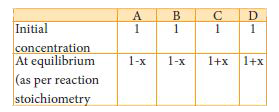The equilibrium constant at 298K for a reactions is 100.
A+B↔C+D
If the initial concentration of all the four species is 1 M, the equilibrium concentration of D (in mol lit−1) will be
[A]=[B]=[C]=[D]=1M
Kc=100,[D]eq=?
Let x be the no moles of reactants reacted

Kc=[C][D][A][B]
100=(1+x)(1+x)(1−x)(1−x)
√100=√(1+x)(1+x)(1−x)(1−x)
10=1+x1−x,10(1−x)=1+x
10−10x−1−x=0
9−11x=0,11x=9
x=911=0.818
[D]eq=1+x=1+0.818=1.818M.
Topper's Solved these Questions
- PHYSICAL AND CHEMICAL EQUILIBRIUMBOOK - NCERT TAMILCHAPTER - PHYSICAL AND CHEMICAL EQUILIBRIUMEXERCISE - EVALUATE YOURSELF
5 Videos
- PHYSICAL AND CHEMICAL EQUILIBRIUMBOOK - NCERT TAMILCHAPTER - PHYSICAL AND CHEMICAL EQUILIBRIUMEXERCISE - EVALUATION (MCQs)
25 Videos
- PERIODIC CLASSIFICATION-IBOOK - NCERT TAMILCHAPTER - PERIODIC CLASSIFICATION-IEXERCISE - Questions (Explain briefly the following)
19 Videos
- PURIFICATION OF ORGANIC COMPOUNDSBOOK - NCERT TAMILCHAPTER - PURIFICATION OF ORGANIC COMPOUNDSEXERCISE - QUESTION
30 Videos
Similar Questions
The equilibrium constant at 298K for a reaction, A+B⇔C+D is 100. If the initial concentrations of all the four species were 1M each, then equilibirum concentration of D (in molL−1) will be
View SolutionThe equilibrium constant at 298 K for the reaction A+B⇔C+Dis 100 If the initial concentration of all the four species were 1M each, then equilibrium concentration of D will be
View Solution
Knowledge Check
The equilibrium constant at 298K for a reaction, A+B⇔C+D is 100. If the initial concentrations of all the four species were 1M each, then equilibirum concentration of D (in molL−1) will be
A1.182B0.182C0.818D1.818The equilibrium constant at 298K for a reaction, A+B⇔C+D is 100. If the initial concentrations of all the four species were 1M each, then equilibirum concentration of D (in molL−1) will be
A0.818B1.818C1.182D0.182The equilibrium constant at 298K for a reaction, A+B⇔C+D is 100. If the initial concentrations of all the four species were 1M each, then equilibirum concentration of D (in molL−1) will be
A1.818B1.182C0.182D0.818
For the reaction
A+B⇔2C
the value of equilibrium constant is 100 at 298 K. If the initial concentration of all the three species is 1 M each, then the equilibrium concentration of C is x×10−1M . The value of x is _______
(Nearest integer)
View SolutionThe equilibrium constant Kc at 298 K for the reaction
A + B = C + D
is 100. Starting with an equimolar solution with concentrations of A, B, C and D all equal to 1 M, the equilibrium concentration of D is ×10−2 M. (Nearest integer)
View SolutionThe equilibrium constant at 298K for a reaction, A+B⇔C+D is 100. If the initial concentrations of all the four species were 1M each, then equilibirum concentration of D (in molL−1) will be
View SolutionThe equilibrium constant at 298K for a reaction, A+B⇔C+D is 100. If the initial concentrations of all the four species were 1M each, then equilibirum concentration of D (in molL−1) will be
View SolutionThe equilibrium constant at 298K for a reaction, A+B⇔C+D is 100. If the initial concentrations of all the four species were 1M each, then equilibirum concentration of D (in molL−1) will be
View Solution
